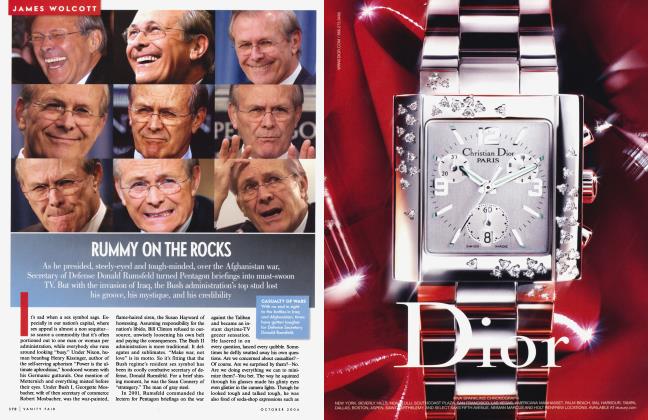Sign In to Your Account
Subscribers have complete access to the archive.
Sign In Not a Subscriber?Join NowLess than Wonderful
JAMES WOLCOTT
JAMES WOLCOTT reassesses Capra's Christmas classic
Mixed Media
To those who love a good cry, Frank Capra's It's a Wonderful Life has become a Christmas classic—a cathartic holiday leak. It's a film with a homesick heart, seeking refuge in a deep, snowy
bosom. James Stewart stars as a twisted rag of worry named George Bailey, whose family obligations and steep financial setbacks have made him feel that he's more valuable dead than alive. (His death would at least result in an insurance payout.) As his wife, Mary, played by Donna Reed, supervises the trimming of the Christmas tree, George lurches toward despondency like a drunk with the blind staggers, not knowing that the light of revelation awaits him. Released in 1946, It's a Wonderful Life was the first Hollywood feature directed by Capra after his distinguished hitch on the propaganda front (as an army colonel assigned to the Office of War Information, he had supervised a series of drumbeat documentaries entitled "Why We Fight''), and the mood of the film is frostbitten, jittery. Pieces of life are missing, and nearly everyone in Capra's fabled town of Bedford Falls is afflicted with frayed nerves—and the fear of debt. (Even more than World War II, the specter of the Great Depression stretches behind the movie like a mass tomb.) There's also a Tinker Bell touch of the supernatural to It's a Wonderful Life, as an ineffectual angel named Clarence (Henry Travers) tries to earn his wings by preventing George from cashing in his earthly chips. It makes for an odd mixture of the stark and the jolly.
Perhaps early audiences thought so, too. Although they didn't ignore or snub the film, it ran second in popularity to The Best Years of Our Lives, a more legato look at postwar adjustment directed by William Wyler. (The Best Years of Our Lives won the Oscar for Best Picture of 1946, with Wyler also beating out Capra for Best Director.) Four decades of scrutiny, however, have reversed their placing. While The Best Years of Our Lives is now discounted by many as a glossy artifact, a back issue, It's a Wonderful Life has picked up a sizable cult of repeat viewers. To these TV converts (and that's where most of them caught the movie— on TV), It's a Wonderful Life isn't a riffle of images but a holy text. Such preachifying, speechifying Capra films as Meet John Doe and Mr. Smith Goes to Washington, not to mention that oasis of sunbeams and idle wisdom known as Lost Horizon, are today seen as pilgrim steps to this, his masterpiece. "The director's claim to greatness remains It's a Wonderful Life no matter how many times it is played, imitated, or parodied," wrote Andrew Sarris this September in the Village Voice. "For the spiritual constant that animates Capra's art does not involve escape and survival, but crucifixion and redemption." If that sounds wiggy—James Stewart climbing toward Calvary, bent beneath a dollar sign— keep in mind that Sarris isn't solo in his opinion. Other critics have chimed in so. And two new books have been issued on Capra and It's a Wonderful Life to add to the procession. This is a procession that must be stopped. Blind guides, ye have swallowed a camel.
T) ut let's dispose of the books before J3we discuss the camel. Jeanine Basinger's "It's a Wonderful Life'' Book (Knopf) is a commemorative volume on the occasion of the film's fortieth anniversary. Despite its lavish format and elaborate apparatus (complete script, background material, interviews with James Stewart and the movie's cinematographer, intro by Frank Capra—and, best of all, a handsome cache of silvery production stills, rich in nostalgia and starglow), the book is essentially a fan's notes. Basinger, the curator of the Frank Capra Archives at Wesleyan University, writes as if she's got her head under a hair dryer: "Bedford Falls itself is a compelling character, changing its costume from season to season. It has its bad days (rain and snow) and its good days (blossoming trees and singing birds). It gets dressed up for Christmas." On Groundhog Day, it stares down holes. The "It's a Wonderful Life'' Book is the kind of film history Gidget would write once she had hung up her surfboard.
Raymond Carney's American Vision: The Films of Frank Capra (Cambridge) is a far heftier sack of wind from the faculty lounge. Carney, a visiting professor at Stanford University, stirred up a pointless fuss earlier this year in The New Republic when he attempted a radical extraction on the reputation of Vincent Canby, the movie critic of the New York Times. Perhaps Carney is jealous of Canby's metropolitan ease, for his book on Capra reads like one of those crimes committed in the name of tenure—it has the shackled clank of duty. Trying to steal some lightning from Harold Bloom's clouded brow, Carney posits Capra not as a comball entertainer but as an Emersonian seer, a visionary in spite of himself. "To oversimplify only slightly, the American idealist position (as descended from Emerson, through Homer, Eakins, and Sargent, to Capra, Ray, and Cassavetes)''—descended is the word!—"may be said to locate itself somewhere between the physicalism of Degas, Renoir, and Monet, on the one hand, and the supernaturalism of the British late Romantic tradition on the other." American Vision is full of crackpot sentences like that, in which Carney loads a lot of Great Names in the stagecoach and whips the horses toward Bedford Falls.
When he does manage to alight on a subject for a concentrated spell, his rhetoric shifts to a mode that might be called Ecumenical Pompous:
However unfashionable the doctrine may be in so-called enlightened circles today, Capra takes his place in a long line of distinguished thinkers who have argued that there is an essential difference be- tween male and female imaginative relationships to the world, men being more abstractly ideational, idealistic, and individualistic than women and suffering the unavoidable and frequent consequences of it in imaginative frustration, criminality, suicide, and sexual predation, as well as reaping the rare benefits of it in the creativity of certain kinds of philosophical, artistic, and scientific invention. (For someone who regards such a view as anathema, it can be said in defense of It's a Wonderful Life that the effect of the film does not overwhelmingly depend upon one's subscription to Capra's sense of a general biological difference in human imaginative tendencies.)
Carney is one awesome dude.
"jVTeither The "It's a Wonderful Life'' 1 yBook (gushing with trivia) nor American Vision (flooded with shallow pensees) is very helpful in pinning down why Capra's galumphing camel of a film has developed such a sentimental hold. The truth is that most of It's a Wonderful Life is just plumb awful. The childhood scene of George being slapped on his sore ear by a drunken druggist has a raw power, like an epi-
sode out of Sherwood Anderson; there is a giddily staged sequence of a highschool dance in which the gym floor separates, imperiling the dancers above a swimming pool; and, most evocative, Bedford Falls often seems suspended in a Christmas paperweight as the director's hand shakes loose a luxurious snowfall—indeed, the shot of George poised on the bridge for a suicide leap, the white flakes dissolving into the ridged black waters below, may be the most sheerly beautiful moment Capra has ever shot. (Sadly, the black-andwhite contrast of these snowfall effects will be lost in the "colorized'' version of the film. It's a Wonderful Life was one of the first properties to undergo this.barbarism, by which old b&w movies are candied for better consumption on TV.) The rest, however, is hick and overstated. As Potter, the town's meanie miser, Lionel Barrymore is pushed around town by pallbearers, his carriage chair the symbol of his rapacious impotence. Childless and friendless, Potter is the sort of crusty stock villain Jack Benny made fun of on radio with his char- acter the Mean Old Man; he functions solely as the unacceptable face of capitalism. (George, who runs his building and loan as if he were collecting pennies in a milk carton, represents the neighborly face of capitalism.) The whole deary-me business of Clarence winning his angel wings is also a bore.
For me, the film falls irretrievably to pieces when George staggers wild-eyed through an ammonia nightmare of what Bedford Falls would have become had he never been bom, a series of gaudy episodes which Camey, characteristically, considers Joycean. Without George, we're shown, Bedford Falls would have turned into a neon honkytonk of sin and gin. And Donna Reed's Mary, who flashed a pretty leg in her courtship scene with George, would have ossified into a spinster wasting away with virginity. The surface message of It's a Wonderful Life is that every man's life is an unforeseen chain of consequences: even a solitary stone causes a ripple. Examined in isolation, George's life may appear small and ordinary, but seen in the totality of its relations, it s been wondrous and good.
There's a deeper discontent that the movie shies away from, however. The tragedy of George Bailey's life is that he never managed to escape from the jostle and poky familiarity of Bedford Falls. Even on his honeymoon, he's forced to stay put and deal with a crisis at the building and loan. George's yearning leaves a pocket of frustration, an ache of unfulfillment, that Capra tries to paste over with his usual toothfairy tricks. But George's misery can't be erased with a wave of the wand.
T)erhaps what has made It's a WonX derful Life such a beloved holiday tradition in recent years is that George Bailey now stands for what we want to believe, and Bedford Falls the home we can't go home to again. It's a Wonderful Life is the perfect film for the Reagan era, celebrating the old-fashioned values of home and hearth that everyone knows deep down have eroded. Its false affirmations—I call them false because they spring not from joy but from anxiety—wouldn't have rung true with viewers had Capra not been sincere. Like Reagan, Capra is a blue-sky optimist who filters out bad news. He seems to have a secret pipeline into people's pining desire for an America of a calendar-art past. But peel away the picturesque snows of Bedford Falls and you have a town as petty and stultifying as any that drove Sinclair Lewis to apoplexy.
The old movie that affects me the way that It's a Wonderful Life affects others is Dodsworth, the 1936 adaptation of Sinclair Lewis's novel, directed by (how felicitous) William Wyler. The message of Dodsworth is quite the opposite of It's a Wonderful Life. Dodsworth is about a retired industrialist—Walter Huston, a marvel of restraint—whose happiness and sense of purpose come to fruition only after he's left America for Europe and shed his mercantile instincts. The atmosphere of the film is calm and open and unjudging. It isn't a civics lesson for the soul. It's a Wonderful Life says, Stay home and tend the flock; Dodsworth says, Old men should make voyages. I think I know on which sentiment I would rather spend my tears. □
 View Full Issue
View Full Issue


















Subscribers have complete access to the archive.
Sign In Not a Subscriber?Join Now